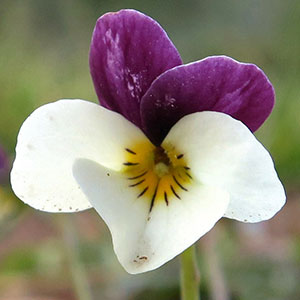Viola pinetorum
Viola hallii
goosefoot yellow violet, mountain yellow violet, pine violet
Hall's violet, Oregon violet, wild pansy
1–3, prostrate or erect, leafy proximally and distally, puberulent or canescent to gray-tomentose, sometimes glabrous, on caudex from subligneous rhizome.
1–3, decumbent or ascending to erect, ca. 1/2 subterranean, glabrous, clustered on single, short, vertical, deep-seated caudex.
basal and cauline;
basal: 1–4;
stipules adnate to petiole forming 2 linear-lanceolate wings, margins entire or laciniate, apex of each wing free, tips usually filamentous;
petiole 2.3–9.5 cm, puberulent or canescent;
blade purple-tinted abaxially or not, usually linear to narrowly lanceolate, oblanceolate or obovate, or lanceolate-elliptic, rarely ovate, 1.3–5 × 0.3–2.5 cm, base attenuate, margins usually lacerate, dentate, or serrate, sometimes entire, usually undulate, ciliate, apex acute, mucronulate, surfaces puberulent to canescent or gray-tomentose;
cauline similar to basal except: stipules lanceolate, oblanceolate, or linear-oblong, margins entire or lacerate, apex acute to acuminate;
petiole 0.9–8.3 cm;
blade 2.8–9.6 × 0.3–1.4 cm, length 4–11 times width.
basal and cauline;
basal: 1–4, palmately compound, ± 2-ternate or 3-ternate, leaflets 3;
stipules adnate to petiole, forming 2 linear-lanceolate wings, unlobed, margins entire, apex of each wing free, acute;
petiole 5–8 cm, glabrous;
blade ovate to deltate, 2.8–6 × 2.6–6.5 cm, ± coriaceous, base tapered, ultimate lobes narrowly elliptic, lanceolate, or oblanceolate, 1–7 mm wide, margins entire, ciliate or eciliate, apex acute, mucronulate, surfaces glabrous;
cauline similar to basal except: stipules usually lanceolate, sometimes broadly ovate, ± leaflike, margins toothed;
petiole 1.3–6 cm;
blade 2–4.8 × 1.2–5.5 cm.
2.9–11.5 cm, puberulent or canescent.
2.5–11 cm, glabrous.
sepals lanceolate, margins ciliate, auricles 0.5–1 mm;
petals deep lemon-yellow adaxially, upper 2 red- to purple-brown abaxially, lower 3 dark brown-veined, lateral 2 bearded, lowest 5–12 mm, spur color same as petals, gibbous, 1.5–3 mm;
style head bearded; cleistogamous flowers axillary.
sepals lanceolate to ovate, margins ciliate, auricles 0.5–1 mm;
petals: upper 2 almost black abaxially, dark reddish violet adaxially, lower 3 pale yellow, cream, or ± white, lateral 2 bearded, with deep yellow to orange patch basally, dark reddish violet-veined, lowest with deep yellow to orange patch basally, dark reddish violet-veined, 5–18 mm, spur yellow, gibbous, 0.5–2 mm;
style head bearded; cleistogamous flowers absent.
ovoid, 3.5–7 mm, puberulent.
ellipsoid, 4–12 mm, glabrous.
medium to dark brown, 2–3.5 mm.
light brown, shiny, 3.2–3.5 mm.
= 12.
= 60, 72.
Viola pinetorum
Viola hallii
Flowers of Viola pinetorum have been observed to close up in late afternoon then fully reopen the following morning.
Although E. O. Wooton and P. C. Standley (1915) reported Viola pinetorum from New Mexico, the plant was probably V. nuttallii. K. W. Allred (2008) noted that V. pinetorum occurs in California; he did not recognize it in New Mexico.
Varieties 2 (2 in the flora).
(Discussion copyrighted by Flora of North America; reprinted with permission.)
Viola hallii was discovered on the grounds of Willamette University in Salem, Oregon, by Elihu Hall, a professor at that institution (V. B. Baird 1942). Leaves of V. hallii are similar to V. beckwithii.
(Discussion copyrighted by Flora of North America; reprinted with permission.)
1. Plants 6.5–18 cm, not cespitose; basal leaf blades 0.7–2.5 cm wide, surfaces puberulent; peduncles 3.4–11.5 cm. | var. pinetorum |
1. Plants 3–7(–9) cm, usually cespitose; basal leaf blades 0.3–1 cm wide, surfaces canescent, sometimes appearing gray-tomentose; peduncles 2.9–6(–7) cm. | var. grisea |


